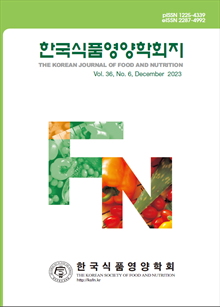간행물
한국식품영양학회지 KCI 등재 The Korean Journal of Food And Nutrition

- 발행기관 한국식품영양학회
- 자료유형 학술지
- 간기 격월간
- ISSN 1225-4339 (Print)2287-4992 (Online)
- 수록기간 1988 ~ 2024
- 주제분류 자연과학 > 생활과학 자연과학 분류의 다른 간행물
- 십진분류KDC 594DDC 641
권호리스트/논문검색
Vol. 24 No. 3 (2011년 9월) 24건
21.
2011.09
구독 인증기관 무료, 개인회원 유료
The purpose of this study was to evaluate the effects of soybean varieties on the physicochemical and sensory characteristics tofu. Five varieties of soybeans(Daewon, Jinpoung, Hwanggum, Jinmi, and Manni) were selected for these experiments. Proximate composition and total phenolic acids in the soybeans, and the moisture, turbidity, lightness, yield rate, texture characteristics, and sensory characteristics of the tofu were measured. The Hwanggum soybeans had the highest levels of crude lipid and crude ash. There was a significant difference in the moisture and yield rate of the tofu(p<0.05). The crude protein and crude lipid contents of the soybeans affected the hardness and springiness of the tofu. In sensory evaluations, significant differences(p<0.05) were shown in taste, texture, and overall acceptability depending on the tofu by soybean variety. Therefore, one should consider soybean varieties when manufacturing tofu.
4,000원
22.
2011.09
구독 인증기관 무료, 개인회원 유료
The effect of subcritical water for the extraction of total polyphenols and flavonoids from apple peel was investigated, and then the antioxidant activity of the extracts was estimated. Maximum yields of total polyphenolic compounds(36.4±1.9 mg quercetin equivalent(QE)/g dried material) and flavonoids(9.9±0.8 ㎎ QE/g dried material) were obtained by subcritical water extraction(SWE) with operating conditions of 190℃, 1, 300 psi, and 20 min. Furthermore, the highest antioxidant activity(76.1±1.1%) was observed in the extract obtained from SWE using the same conditions. The flavonoids from the SWE of apple peel were compared to three conventional extraction methods in terms of their extraction efficiency and antioxidant activity. The SWE was significantly more effective than hot water (90℃), methanol, and ethanol extraction for flavonoid yield by 4.7-, 2.2-, and 1.3-fold, respectively, and for antioxidant activity by 11.0-, 4.9, and 2.8-fold, respectively.
4,000원
23.
2011.09
구독 인증기관 무료, 개인회원 유료
Thermally processed vegetables have long been considered to have lower nutritional values compared to fresh produce. This consideration is based on the fact that ascorbic acid(vitamin C) or other thermolabile compounds may lose their activity due to oxidation or by consequence of leaching into the water during home cooking or industrial processing, such as by blanching. In this study, major agricultural products such as carrots, broccoli, and potatoes were exposed to steam treatments of different types. Then, changes in color and levels of ascorbic acid, carotene, and moisture in the fresh and steam processed vegetable samples were measured and evaluated. The results clearly showed that steam-processing using a natural convection type method was superior to the other treatments in terms of quality, including color and nutrient retention, among all the vegetables tested.
4,000원
24.
2011.09
구독 인증기관 무료, 개인회원 유료
This study analyzes flavor ingredients according to types of whisky and maturation periods based on total 40 different types of whisky that are mainly distributed to Korea via imports. Whisky was classified into four categories based on origin, and also into different categories based on maturity period, ingredients such as fusel alcohol, fatty acid, and fatty acid esters and proportion of patterns were analyzed. As a result of an analysis for fusel alcohol, high qualified types of alcohol including 3-methylbutanol, 2-methylbutanol, iso-butanol, and 1-propanol were detected from all Scotch whiskys, America whiskys, and Canadian whiskys. In particular, the proportional sum of 3-methylbutanol and 2-methylbutanol, and the sum of 3-methylbutanol and 2-methylbutanol/iso-butanol were regarded as core factors to determine each type of whisky. Acetaldehyde, ethyl acetate, and acetic acid increased as maturation and storage period became longer. As a result of the fatty acid and fatty acid ethyl ester analysis, the major fatty acids were dodecanoic acid and decanoic acid, both with detection of octanoic acid and hexanoic acid. However, dodecanoic acid, decanoic acid, and octanoic acid were lower than the detectable limit in American and Canadian whiskys, showing a unique phenomenon that hexanoic acid was detected only in very small amounts. Malt Scotch whisky showed higher significance than blended Scotch whisky, making it possible to classify types of whisky. Fatty acid ethyl ester contents showed significance with fatty acid either. In addition, changes in the whiskys based on maturation period were confirmed via proportions of fatty acids and fatty acid ethyl esters. In general, the proportion of fatty acids and fatty acid ethyl esters decreased as the storage period increased. This study provided basic data to classify types of whisky based on maturation periods by analyzing the proportion of flavor ingredients such as fusel alcohols, fatty acids, and fatty acid ethyl esters.
4,000원
1
2

